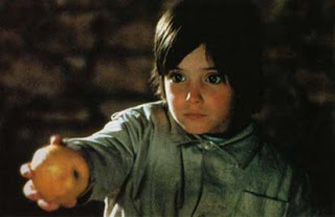Sole Criterion: The Spirit of the Beehive
By Brett Ballard-Beach
November 23, 2012
“Shortly after the Spanish civil war, a six-year-old girl attends a traveling movie show of Frankenstein and becomes haunted by her memory of it.”
Summary of The Spirit of the Beehive from my county library’s online catalogue.
With this week’s entry for Sole Criterion, I achieved close to my stated goal from last December: to push myself to choose films that were, if not necessarily so by country of origin, nonetheless foreign to me. The above summary, running time (99 minutes) and year (1973) were about all I knew in regards to this week’s film before watching it. I didn’t even know the director and didn’t look up his filmography until afterwards. I went in as blind as I ever have (and admittedly rarely do) in order to avert preconceptions and form my own undiluted opinions in advance.
For those who like the short of it upfront, I offer this: The Spirit of the Beehive is Pan’s Labyrinth minus about 98% of the fantastical elements and with a far more ambiguous and unsettling view of its characters. It contains a deep-seated sadness that is disturbing, all the more so because it steadfastly refuses to exploit that emotion or push it to the forefront. It’s a part of the film’s foundation, or its bloodstream. As director Victor Erice notes in an interview that accompanies a 25th anniversary documentary about the making of the film, his screenplay was not about presenting psychological portraits, but about a glimpse from a distance of a family observed with detachment, and of the power of film to capture the imagination, particularly of children.
The key image of the film (and one which The Spirit of the Beehive boldly chooses to recreate towards the end) is from the 1931 James Whale movie Frankenstein, with the escaped monster and a little girl facing each other alongside the shore of a lake. The moment culminates in the monster’s accidental drowning of the girl and for six-year-old Ana, who is watching the film with her older sister Isabel in their isolated Spanish village in 1940, it becomes a touchstone. She wants to know why he killed her and why the villagers then killed him. Isabel’s eventual reply skirts the issue in two ways, and showcases both her trickery of her little sister and her own naïveté: 1) No one really died because it’s a movie and movies are fake. 2) The monster’s spirit lives on nearby and if Ana really believes and wants to, she can talk to him. Ana takes this at face value.
But the film isn’t simply a fable about how her belief and imagination lift her up out of her isolation. Erice considers the family as a whole, each segmented from the other, and how the family unit is fragmented as a result, if not necessarily dysfunctional. (On a side note, I considered that an American take on the tale would have to be an indictment of middle-class suburbia a la American Beauty and that a French version would have to involve incest and/or repressed emotions bubbling up the surface.)
Continued:
1
2
3
4




